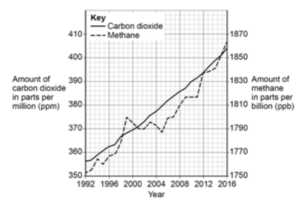Global Climate Change & Carbon Footprint (GCSE Chemistry)
Global Climate Change & Carbon Footprint
Global Climate Change
Scientific Evidence
- Atmospheric greenhouse gases are increasing. As we’ve already seen, the amount of greenhouse gases in the Earth’s atmosphere are increasing. This will increase the temperature of the Earth’s surface.
- Global climate change is occurring. Due to this increase in temperature, scientists have seen that global climate change is occurring. This is based on peer-reviewed evidence.
Bias in Climate Change
- Global climate change is complex. Climate change is a very complex system, which is difficult to model. This means that any explanations that are created will be too oversimplified.
- Media-presented evidence may be biased. Since we are unable to accurately model the complex system of climate change, any evidence presented in the media may become biased. The media may only present part of the evidence, making it biased.

Climate Change
Increasing Temperatures
- The Earth’s temperature is increasing. As we’ve seen earlier, the temperature of the Earth is increasing. This is due to the greenhouse effect and the increase of greenhouse gases being produced.
- Increasing temperatures contribute to climate change. The increasing temperature of the Earth is a major cause of climate change. This is based on the peer-reviewed evidence we discussed earlier.
Effects of Climate Change
- Global climate change has several effects. The increasing temperature of the Earth and resulting climate change have several effects. These effects are outlined in this section.
- Ice caps can melt. The polar ice caps can melt due to the increased temperature, leading to an increase in sea levels. This results in flooding and even coastal erosion.
- Habitats will be lost. Reduction of ice caps reduces the habitat of certain species like polar bears.
- Food production can be affected. Due to changes in amount of rainfall, food production can be affected in certain areas. There may be too much rainfall or too little rainfall for crops to grow.
- Increased desertification. Some areas will become hotter and drier, with more drought, leading to increased desertification.
- Species distribution can change. Again, due to changes in rainfall and storms, the distribution of species can change. The water levels in their habitats may be negatively affected. Some animals may not evolve fast enough and increased rates of extinctions will occur
- More severe weather is likely. More hurricanes and storms are likely to occur.
Carbon Footprint
The definition of carbon footprint is the total amount of carbon dioxide and other greenhouse gases emitted over the full life cycle of a product service or event.
Measuring Greenhouse Gas Emissions
- Carbon footprints are a measurement tool. Carbon footprints can be used to measure emissions of greenhouse gases. They specifically relate to the emissions from a particular product, service or event.
- Carbon footprints consider various factors. When a carbon footprint is calculated, various factors are taken into account. Factors such as production of resources, their usage and their disposal all need to be considered.
Reducing Carbon Footprints
- Carbon footprints can be reduced. In order to reduce a carbon footprint, the emissions of greenhouse gases need to be reduced. For example, the amount of greenhouses gases used for transportation should be limited.
- Renewable energy sources can be used. By using renewable energy sources, we can reduce emissions of greenhouse gases such as carbon dioxide and methane. This can reduce the carbon footprint.
- Increasing energy efficiency can reduce emissions. If we can increase the energy efficiency of processes, we can reduce the amount of waste we produce. This in turn leads to less waste decomposition and therefore less emissions of methane.
- There are other methods to reduce carbon footprint. These include:
- More recycling/ re-using as less waste is sent to landfill so less methane is made.
- Walking to school instead of driving. Less carbon dioxide is given off by burning petrol.
- Use buses instead of cars. More people are carried on one bus, so less carbon dioxide is made by taking more people on the same journey in one vehicle.
- Take showers instead of baths. Less energy is used so less fuel is burn and less carbon dioxide made.
- Eat less meat. Less animals are farmed and less methane is made.
- Reducing carbon footprints is difficult. Although the measures described above can reduce carbon footprints, they are difficult to implement. There are a limited number of renewable energy sources, and many measures need government backing to implement.
Global climate change refers to the long-term changes in the Earth’s climate, such as the increase in global temperatures, caused by human activities that release greenhouse gases into the atmosphere.
Greenhouse gases are gases that trap heat in the Earth’s atmosphere, such as carbon dioxide, methane, and water vapor.
The carbon footprint is the total amount of greenhouse gases, primarily carbon dioxide, that are emitted by an individual, organization, or product.
Human activities that contribute to global climate change include burning fossil fuels, deforestation, and agriculture.
Burning fossil fuels, such as coal, oil, and natural gas, releases carbon dioxide into the atmosphere, which traps heat and contributes to global warming.
Deforestation, or the clearing of forests for agriculture, industry, or urban development, reduces the number of trees that absorb carbon dioxide through photosynthesis, contributing to higher levels of carbon dioxide in the atmosphere.
Agriculture contributes to global climate change through the production of methane and nitrous oxide, two potent greenhouse gases, as well as the use of fertilizers that release nitrous oxide into the atmosphere.
Some ways to reduce your carbon footprint include using public transportation, eating a plant-based diet, using energy-efficient appliances, and reducing your use of single-use plastics.
Some ways to address global climate change on a larger scale include transitioning to renewable energy sources, implementing policies to reduce greenhouse gas emissions, and investing in technologies to capture and store carbon dioxide.





Still got a question? Leave a comment
Leave a comment